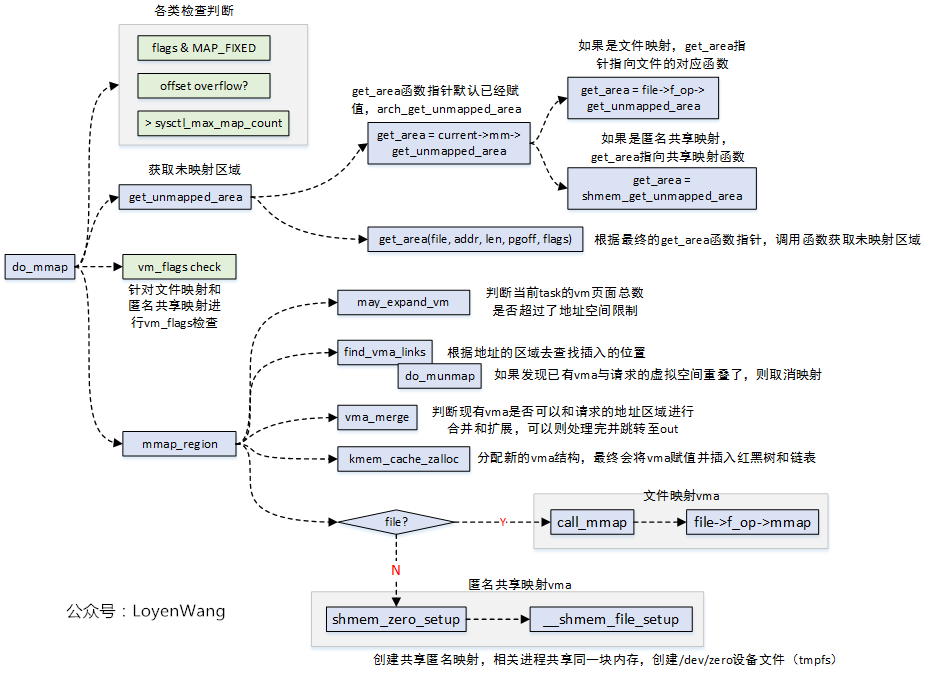背景 By 魯迅 By 高爾基 說明: 1. Kernel版本:4.14 2. ARM64處理器,Contex A53,雙核 3. 使用工具:Source Insight 3.5, Visio 1. 概述 這篇文章,讓我們來看看用戶態進程的地址空間情況,主要會包括以下: ; ; ; 進程地址空間中, ...
背景
Read the fucking source code!--By 魯迅A picture is worth a thousand words.--By 高爾基
說明:
- Kernel版本:4.14
- ARM64處理器,Contex-A53,雙核
- 使用工具:Source Insight 3.5, Visio
1. 概述
這篇文章,讓我們來看看用戶態進程的地址空間情況,主要會包括以下:
vma;malloc;mmap;
進程地址空間中,我們常見的代碼段,數據段,bss段等,實際上都是一段地址空間區域。Linux將地址空間中的區域稱為Virtual Memory Area, 簡稱VMA,使用struct vm_area_struct來描述。
在進行記憶體申請和映射時,都會去地址空間中申請一段虛擬地址區域,而這部分操作也與vma關係密切,因此本文將vma/malloc/mmap三個放到一塊來進行分析。
開啟探索之旅吧。
2. 數據結構
主要涉及兩個結構體:struct mm_struct和struct vm_area_struct。
struct mm_struct
用於描述與進程地址空間有關的全部信息,這個結構也包含在進程描述符中,關鍵欄位的描述見註釋。
struct mm_struct {
struct vm_area_struct *mmap; /* list of VMAs */ //指向VMA對象的鏈表頭
struct rb_root mm_rb; //指向VMA對象的紅黑樹的根
u64 vmacache_seqnum; /* per-thread vmacache */
#ifdef CONFIG_MMU
unsigned long (*get_unmapped_area) (struct file *filp,
unsigned long addr, unsigned long len,
unsigned long pgoff, unsigned long flags); // 在進程地址空間中搜索有效線性地址區間的方法
#endif
unsigned long mmap_base; /* base of mmap area */
unsigned long mmap_legacy_base; /* base of mmap area in bottom-up allocations */
#ifdef CONFIG_HAVE_ARCH_COMPAT_MMAP_BASES
/* Base adresses for compatible mmap() */
unsigned long mmap_compat_base;
unsigned long mmap_compat_legacy_base;
#endif
unsigned long task_size; /* size of task vm space */
unsigned long highest_vm_end; /* highest vma end address */
pgd_t * pgd; //指向頁全局目錄
/**
* @mm_users: The number of users including userspace.
*
* Use mmget()/mmget_not_zero()/mmput() to modify. When this drops
* to 0 (i.e. when the task exits and there are no other temporary
* reference holders), we also release a reference on @mm_count
* (which may then free the &struct mm_struct if @mm_count also
* drops to 0).
*/
atomic_t mm_users; //使用計數器
/**
* @mm_count: The number of references to &struct mm_struct
* (@mm_users count as 1).
*
* Use mmgrab()/mmdrop() to modify. When this drops to 0, the
* &struct mm_struct is freed.
*/
atomic_t mm_count; //使用計數器
atomic_long_t nr_ptes; /* PTE page table pages */ //進程頁表數
#if CONFIG_PGTABLE_LEVELS > 2
atomic_long_t nr_pmds; /* PMD page table pages */
#endif
int map_count; /* number of VMAs */ //VMA的個數
spinlock_t page_table_lock; /* Protects page tables and some counters */
struct rw_semaphore mmap_sem;
struct list_head mmlist; /* List of maybe swapped mm's. These are globally strung
* together off init_mm.mmlist, and are protected
* by mmlist_lock
*/
unsigned long hiwater_rss; /* High-watermark of RSS usage */
unsigned long hiwater_vm; /* High-water virtual memory usage */
unsigned long total_vm; /* Total pages mapped */ //進程地址空間的頁數
unsigned long locked_vm; /* Pages that have PG_mlocked set */ //鎖住的頁數,不能換出
unsigned long pinned_vm; /* Refcount permanently increased */
unsigned long data_vm; /* VM_WRITE & ~VM_SHARED & ~VM_STACK */ //數據段記憶體的頁數
unsigned long exec_vm; /* VM_EXEC & ~VM_WRITE & ~VM_STACK */ //可執行記憶體映射的頁數
unsigned long stack_vm; /* VM_STACK */ //用戶態堆棧的頁數
unsigned long def_flags;
unsigned long start_code, end_code, start_data, end_data; //代碼段,數據段等的地址
unsigned long start_brk, brk, start_stack; //堆棧段的地址,start_stack表示用戶態堆棧的起始地址,brk為堆的當前最後地址
unsigned long arg_start, arg_end, env_start, env_end; //命令行參數的地址,環境變數的地址
unsigned long saved_auxv[AT_VECTOR_SIZE]; /* for /proc/PID/auxv */
/*
* Special counters, in some configurations protected by the
* page_table_lock, in other configurations by being atomic.
*/
struct mm_rss_stat rss_stat;
struct linux_binfmt *binfmt;
cpumask_var_t cpu_vm_mask_var;
/* Architecture-specific MM context */
mm_context_t context;
unsigned long flags; /* Must use atomic bitops to access the bits */
struct core_state *core_state; /* coredumping support */
#ifdef CONFIG_MEMBARRIER
atomic_t membarrier_state;
#endif
#ifdef CONFIG_AIO
spinlock_t ioctx_lock;
struct kioctx_table __rcu *ioctx_table;
#endif
#ifdef CONFIG_MEMCG
/*
* "owner" points to a task that is regarded as the canonical
* user/owner of this mm. All of the following must be true in
* order for it to be changed:
*
* current == mm->owner
* current->mm != mm
* new_owner->mm == mm
* new_owner->alloc_lock is held
*/
struct task_struct __rcu *owner;
#endif
struct user_namespace *user_ns;
/* store ref to file /proc/<pid>/exe symlink points to */
struct file __rcu *exe_file;
#ifdef CONFIG_MMU_NOTIFIER
struct mmu_notifier_mm *mmu_notifier_mm;
#endif
#if defined(CONFIG_TRANSPARENT_HUGEPAGE) && !USE_SPLIT_PMD_PTLOCKS
pgtable_t pmd_huge_pte; /* protected by page_table_lock */
#endif
#ifdef CONFIG_CPUMASK_OFFSTACK
struct cpumask cpumask_allocation;
#endif
#ifdef CONFIG_NUMA_BALANCING
/*
* numa_next_scan is the next time that the PTEs will be marked
* pte_numa. NUMA hinting faults will gather statistics and migrate
* pages to new nodes if necessary.
*/
unsigned long numa_next_scan;
/* Restart point for scanning and setting pte_numa */
unsigned long numa_scan_offset;
/* numa_scan_seq prevents two threads setting pte_numa */
int numa_scan_seq;
#endif
/*
* An operation with batched TLB flushing is going on. Anything that
* can move process memory needs to flush the TLB when moving a
* PROT_NONE or PROT_NUMA mapped page.
*/
atomic_t tlb_flush_pending;
#ifdef CONFIG_ARCH_WANT_BATCHED_UNMAP_TLB_FLUSH
/* See flush_tlb_batched_pending() */
bool tlb_flush_batched;
#endif
struct uprobes_state uprobes_state;
#ifdef CONFIG_HUGETLB_PAGE
atomic_long_t hugetlb_usage;
#endif
struct work_struct async_put_work;
#if IS_ENABLED(CONFIG_HMM)
/* HMM needs to track a few things per mm */
struct hmm *hmm;
#endif
} __randomize_layout;struct vm_area_struct
用於描述進程地址空間中的一段虛擬區域,每一個VMA都對應一個struct vm_area_struct。
/*
* This struct defines a memory VMM memory area. There is one of these
* per VM-area/task. A VM area is any part of the process virtual memory
* space that has a special rule for the page-fault handlers (ie a shared
* library, the executable area etc).
*/
struct vm_area_struct {
/* The first cache line has the info for VMA tree walking. */
unsigned long vm_start; /* Our start address within vm_mm. */ //起始地址
unsigned long vm_end; /* The first byte after our end address
within vm_mm. */ //結束地址,區間中不包含結束地址
/* linked list of VM areas per task, sorted by address */ //按起始地址排序的鏈表
struct vm_area_struct *vm_next, *vm_prev;
struct rb_node vm_rb; //紅黑樹節點
/*
* Largest free memory gap in bytes to the left of this VMA.
* Either between this VMA and vma->vm_prev, or between one of the
* VMAs below us in the VMA rbtree and its ->vm_prev. This helps
* get_unmapped_area find a free area of the right size.
*/
unsigned long rb_subtree_gap;
/* Second cache line starts here. */
struct mm_struct *vm_mm; /* The address space we belong to. */
pgprot_t vm_page_prot; /* Access permissions of this VMA. */
unsigned long vm_flags; /* Flags, see mm.h. */
/*
* For areas with an address space and backing store,
* linkage into the address_space->i_mmap interval tree.
*/
struct {
struct rb_node rb;
unsigned long rb_subtree_last;
} shared;
/*
* A file's MAP_PRIVATE vma can be in both i_mmap tree and anon_vma
* list, after a COW of one of the file pages. A MAP_SHARED vma
* can only be in the i_mmap tree. An anonymous MAP_PRIVATE, stack
* or brk vma (with NULL file) can only be in an anon_vma list.
*/
struct list_head anon_vma_chain; /* Serialized by mmap_sem &
* page_table_lock */
struct anon_vma *anon_vma; /* Serialized by page_table_lock */
/* Function pointers to deal with this struct. */
const struct vm_operations_struct *vm_ops;
/* Information about our backing store: */
unsigned long vm_pgoff; /* Offset (within vm_file) in PAGE_SIZE
units */
struct file * vm_file; /* File we map to (can be NULL). */ //指向文件的一個打開實例
void * vm_private_data; /* was vm_pte (shared mem) */
atomic_long_t swap_readahead_info;
#ifndef CONFIG_MMU
struct vm_region *vm_region; /* NOMMU mapping region */
#endif
#ifdef CONFIG_NUMA
struct mempolicy *vm_policy; /* NUMA policy for the VMA */
#endif
struct vm_userfaultfd_ctx vm_userfaultfd_ctx;
} __randomize_layout;關係圖來了:
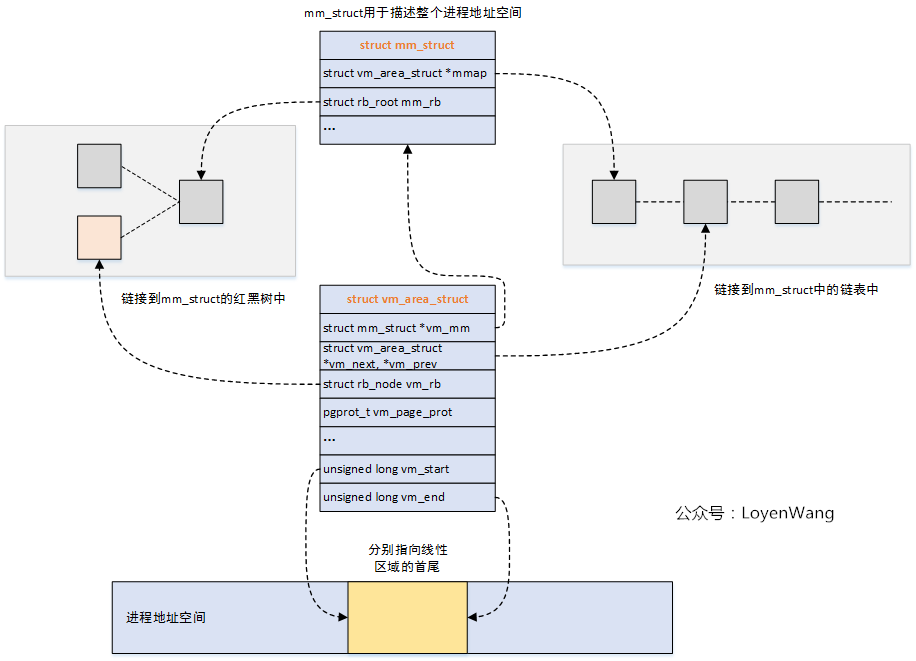
是不是有點眼熟?這個跟內核中的vmap機制很類似。
巨集觀的看一下進程地址空間中的各個VMA:
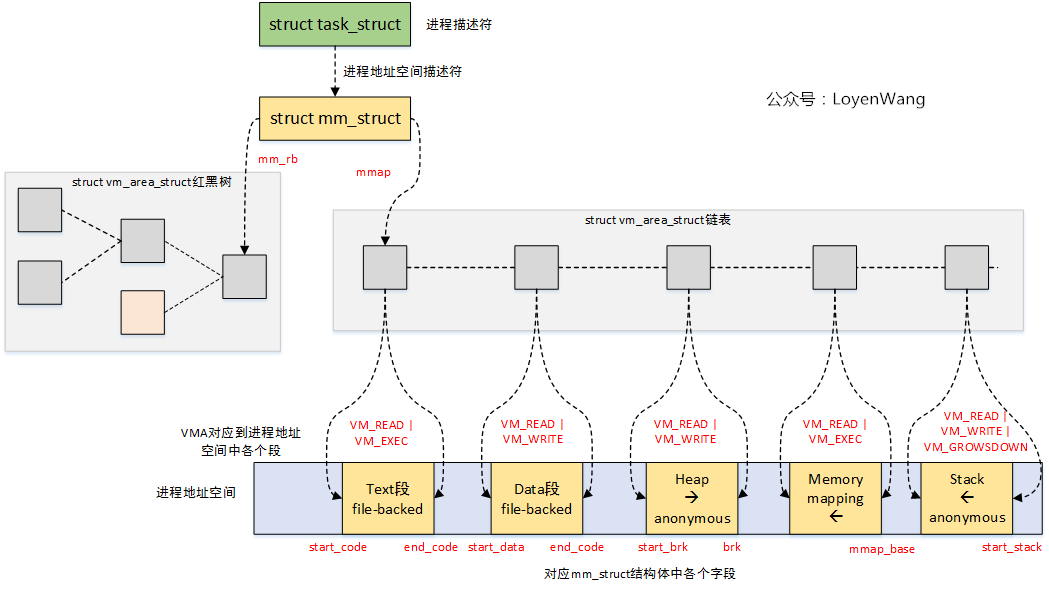
針對VMA的操作,有如下介面:
/* VMA的查找 */
/* Look up the first VMA which satisfies addr < vm_end, NULL if none. */
extern struct vm_area_struct * find_vma(struct mm_struct * mm, unsigned long addr); //查找第一個滿足addr < vm_end的VMA塊
extern struct vm_area_struct * find_vma_prev(struct mm_struct * mm, unsigned long addr,
struct vm_area_struct **pprev); //與find_vma功能類似,不同之處在於還會返回VMA鏈接的前一個VMA;
static inline struct vm_area_struct * find_vma_intersection(struct mm_struct * mm, unsigned long start_addr, unsigned long end_addr); //查找與start_addr~end_addr區域有交集的VMA
/* VMA的插入 */
extern int insert_vm_struct(struct mm_struct *, struct vm_area_struct *); //插入VMA到紅黑樹中和鏈表中
/* VMA的合併 */
extern struct vm_area_struct *vma_merge(struct mm_struct *,
struct vm_area_struct *prev, unsigned long addr, unsigned long end,
unsigned long vm_flags, struct anon_vma *, struct file *, pgoff_t,
struct mempolicy *, struct vm_userfaultfd_ctx); //將VMA與附近的VMA進行融合操作
/* VMA的拆分 */
extern int split_vma(struct mm_struct *, struct vm_area_struct *,
unsigned long addr, int new_below); //將VMA以addr為界線分成兩個VMA上述的操作基本上也就是針對紅黑樹的操作。
3. malloc
malloc大家都很熟悉,那麼它是怎麼與底層去交互並申請到記憶體的呢?
圖來了:
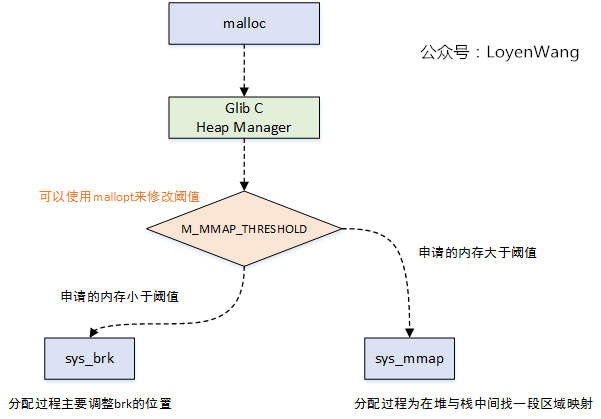
如圖所示,malloc最終會調到底層的sys_brk函數和sys_mmap函數,在分配小記憶體時調用sys_brk函數,動態的調整進程地址空間中的brk位置;在分配大塊記憶體時,調用sys_mmap函數,在堆和棧之間找到一片區域進行映射處理。
先來看sys_brk函數,通過SYSCALL_DEFINE1來定義,整體的函數調用流程如下:
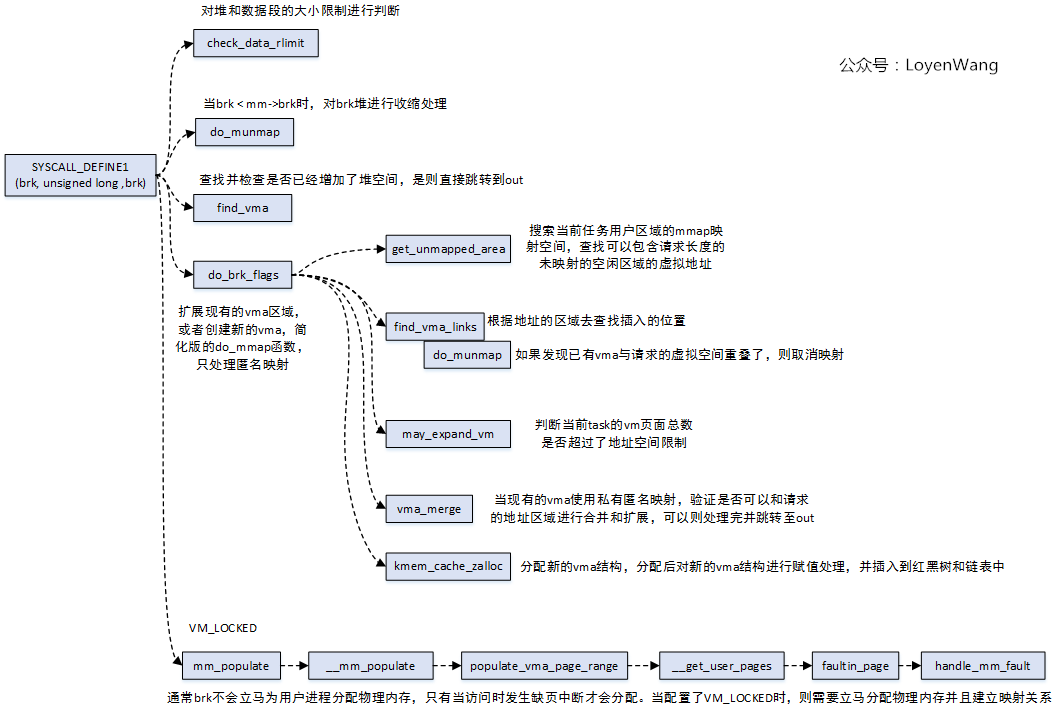
從函數的調用過程中可以看出有不少操作是針對vma的,那麼結合起來的效果圖如下:

整個過程看起來就比較清晰和簡單了,每個進程都用struct mm_struct來描述自身的進程地址空間,這些空間都是一些vma區域,通過一個紅黑樹和鏈表來管理。因此針對malloc的處理,會去動態的調整brk的位置,具體的大小則由struct vm_area_struct結構中的vm_start ~ vm_end來指定。在實際過程中,會根據請求分配區域是否與現有vma重疊的情況來進行處理,或者重新申請一個vma來描述這段區域,並最終插入到紅黑樹和鏈表中。
完成這段申請後,只是開闢了一段區域,通常還不會立馬分配物理記憶體,物理記憶體的分配會發生在訪問時出現缺頁異常後再處理,這個後續也會有文章來進一步分析。
4. mmap
mmap用於記憶體映射,也就是將一段區域映射到自己的進程地址空間中,分為兩種:
- 文件映射: 將文件區域映射到進程空間,文件存放在存儲設備上;
- 匿名映射:沒有文件對應的區域映射,內容存放在物理記憶體上;
同時,針對其他進程是否可見,又分為兩種:
- 私有映射:將數據源拷貝副本,不影響其他進程;
- 共用映射:共用的進程都能看到;
根據排列組合,就存在以下幾種情況了:
- 私有匿名映射: 通常分配大塊記憶體時使用,堆,棧,bss段等;
- 共用匿名映射:常用於父子進程間通信,在記憶體文件系統中創建
/dev/zero設備; - 私有文件映射:常用的比如動態庫載入,代碼段,數據段等;
- 共用文件映射:常用於進程間通信,文件讀寫等;
常見的prot許可權和flags如下:
#define PROT_READ 0x1 /* page can be read */
#define PROT_WRITE 0x2 /* page can be written */
#define PROT_EXEC 0x4 /* page can be executed */
#define PROT_SEM 0x8 /* page may be used for atomic ops */
#define PROT_NONE 0x0 /* page can not be accessed */
#define PROT_GROWSDOWN 0x01000000 /* mprotect flag: extend change to start of growsdown vma */
#define PROT_GROWSUP 0x02000000 /* mprotect flag: extend change to end of growsup vma */
#define MAP_SHARED 0x01 /* Share changes */
#define MAP_PRIVATE 0x02 /* Changes are private */
#define MAP_TYPE 0x0f /* Mask for type of mapping */
#define MAP_FIXED 0x10 /* Interpret addr exactly */
#define MAP_ANONYMOUS 0x20 /* don't use a file */
#define MAP_GROWSDOWN 0x0100 /* stack-like segment */
#define MAP_DENYWRITE 0x0800 /* ETXTBSY */
#define MAP_EXECUTABLE 0x1000 /* mark it as an executable */
#define MAP_LOCKED 0x2000 /* pages are locked */
#define MAP_NORESERVE 0x4000 /* don't check for reservations */
#define MAP_POPULATE 0x8000 /* populate (prefault) pagetables */
#define MAP_NONBLOCK 0x10000 /* do not block on IO */
#define MAP_STACK 0x20000 /* give out an address that is best suited for process/thread stacks */
#define MAP_HUGETLB 0x40000 /* create a huge page mapping */mmap的操作,最終會調用到do_mmap函數,最後來一張調用圖:
